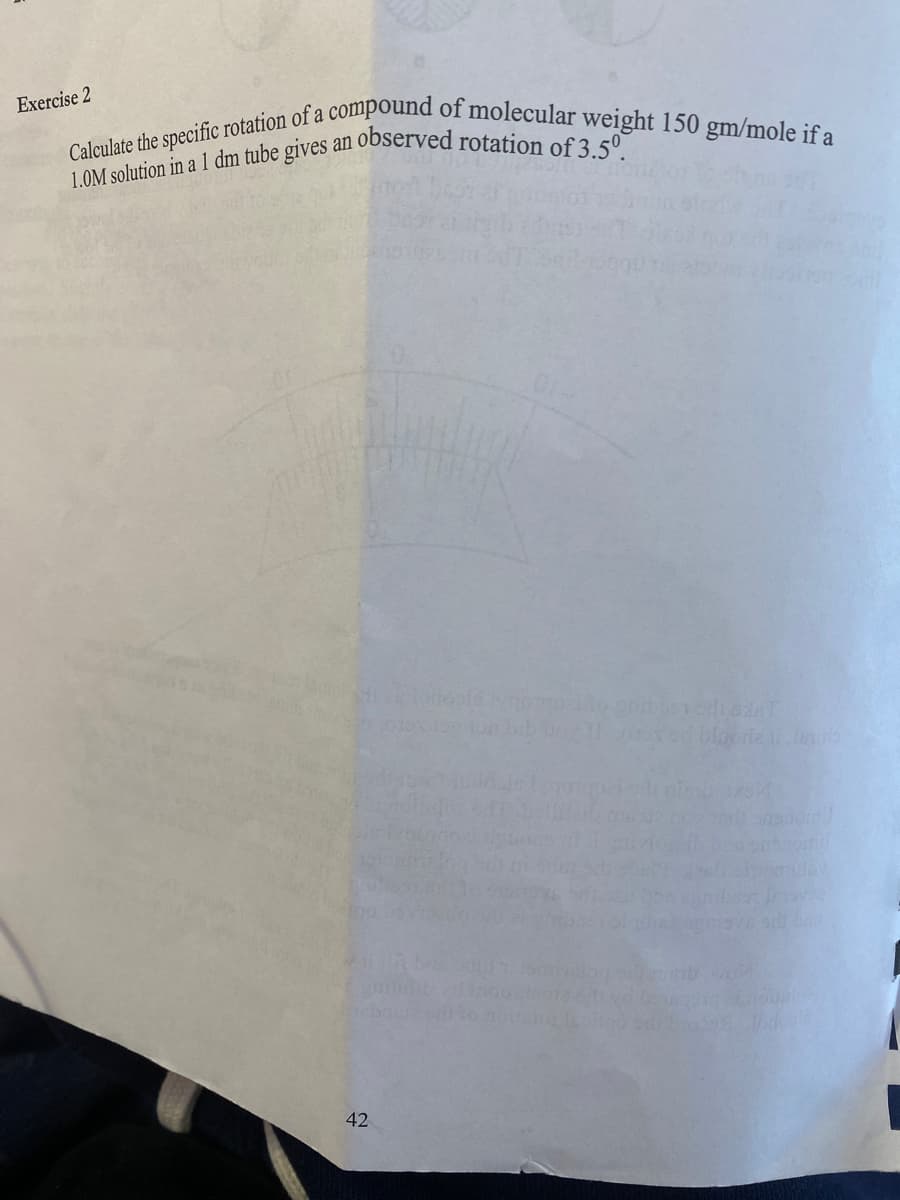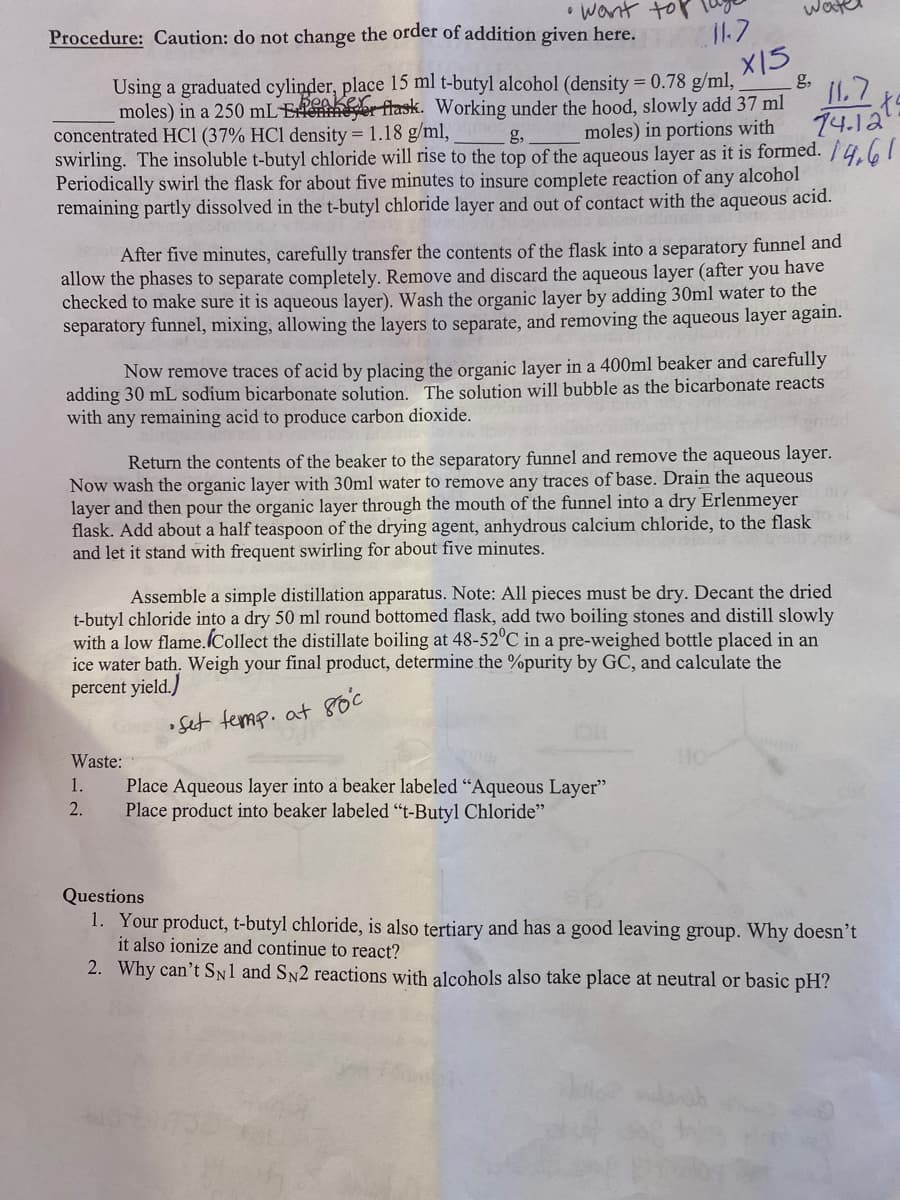=rcise 2 Calculate the specific rotation of a compound of molecular weight 150 gm/mole if a 1.0M solution in a 1 dm tube gives an observed rotation of 3.50.
=rcise 2 Calculate the specific rotation of a compound of molecular weight 150 gm/mole if a 1.0M solution in a 1 dm tube gives an observed rotation of 3.50.
Introductory Chemistry: A Foundation
9th Edition
ISBN:9781337399425
Author:Steven S. Zumdahl, Donald J. DeCoste
Publisher:Steven S. Zumdahl, Donald J. DeCoste
Chapter5: Nomenclature
Section5.5: Naming Compounds That Contain Polyatomic Ions
Problem 5.6SC: Exercise 5.6 Name each of the following compounds. a.Ca(OH)2d.(NH4)2Cr2O7g.Cu(NO2)2...
Related questions
Question
Need help answering these three questions

Transcribed Image Text:Exercise 2
Calculate the specific rotation of a compound of molecular weight 150 gm/mole if a
1.0M solution in a 1 dm tube gives an observed rotation of 3.5⁰.
42
blooria ir lub

Transcribed Image Text:• want top
Procedure: Caution: do not change the order of addition given here.
11.7
x15
g,
16.7
Using a graduated cylinder, place 15 ml t-butyl alcohol (density = 0.78 g/ml,
moles) in a 250 mL-Eether flask. Working under the hood, slowly add 37 ml
concentrated HC1 (37% HCl density = 1.18 g/ml,
moles) in portions with
swirling. The insoluble t-butyl chloride will rise to the top of the aqueous layer as it is formed. 14,61
Periodically swirl the flask for about five minutes to insure complete reaction of any alcohol
remaining partly dissolved in the t-butyl chloride layer and out of contact with the aqueous acid.
g,
74.12
wat
2000 After five minutes, carefully transfer the contents of the flask into a separatory funnel and
allow the phases to separate completely. Remove and discard the aqueous layer (after you have
checked to make sure it is aqueous layer). Wash the organic layer by adding 30ml water to the
separatory funnel, mixing, allowing the layers to separate, and removing the aqueous layer again.
Now remove traces of acid by placing the organic layer in a 400ml beaker and carefully
adding 30 mL sodium bicarbonate solution. The solution will bubble as the bicarbonate reacts
with any remaining acid to produce carbon dioxide.
Ret the contents of the beaker to the separatory funnel and remove the aqueous layer.
Now wash the organic layer with 30ml water to remove any traces of base. Drain the aqueous
layer and then pour the organic layer through the mouth of the funnel into a dry Erlenmeyer
flask. Add about a half teaspoon of the drying agent, anhydrous calcium chloride, to the flask
and let it stand with frequent swirling for about five minutes.
Waste:
1.
2.
Assemble a simple distillation apparatus. Note: All pieces must be dry. Decant the dried
t-butyl chloride into a dry 50 ml round bottomed flask, add two boiling stones and distill slowly
with a low flame. Collect the distillate boiling at 48-52°C in a pre-weighed bottle placed in an
ice water bath. Weigh your final product, determine the %purity by GC, and calculate the
percent yield.)
•Set temp. at 80°c
Place Aqueous layer into a beaker labeled "Aqueous Layer"
Place product into beaker labeled "t-Butyl Chloride"
Questions
1. Your product, t-butyl chloride, is also tertiary and has a good leaving group. Why doesn't
it also ionize and continue to react?
2. Why can't SNl1 and SN2 reactions with alcohols also take place at neutral or basic pH?
ts
Expert Solution
This question has been solved!
Explore an expertly crafted, step-by-step solution for a thorough understanding of key concepts.
Step by step
Solved in 2 steps

Knowledge Booster
Learn more about
Need a deep-dive on the concept behind this application? Look no further. Learn more about this topic, chemistry and related others by exploring similar questions and additional content below.Recommended textbooks for you

Introductory Chemistry: A Foundation
Chemistry
ISBN:
9781337399425
Author:
Steven S. Zumdahl, Donald J. DeCoste
Publisher:
Cengage Learning

General Chemistry - Standalone book (MindTap Cour…
Chemistry
ISBN:
9781305580343
Author:
Steven D. Gammon, Ebbing, Darrell Ebbing, Steven D., Darrell; Gammon, Darrell Ebbing; Steven D. Gammon, Darrell D.; Gammon, Ebbing; Steven D. Gammon; Darrell
Publisher:
Cengage Learning

Organic And Biological Chemistry
Chemistry
ISBN:
9781305081079
Author:
STOKER, H. Stephen (howard Stephen)
Publisher:
Cengage Learning,

Introductory Chemistry: A Foundation
Chemistry
ISBN:
9781337399425
Author:
Steven S. Zumdahl, Donald J. DeCoste
Publisher:
Cengage Learning

General Chemistry - Standalone book (MindTap Cour…
Chemistry
ISBN:
9781305580343
Author:
Steven D. Gammon, Ebbing, Darrell Ebbing, Steven D., Darrell; Gammon, Darrell Ebbing; Steven D. Gammon, Darrell D.; Gammon, Ebbing; Steven D. Gammon; Darrell
Publisher:
Cengage Learning

Organic And Biological Chemistry
Chemistry
ISBN:
9781305081079
Author:
STOKER, H. Stephen (howard Stephen)
Publisher:
Cengage Learning,

General, Organic, and Biological Chemistry
Chemistry
ISBN:
9781285853918
Author:
H. Stephen Stoker
Publisher:
Cengage Learning